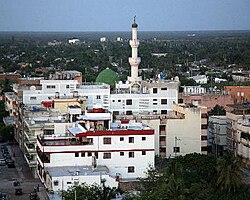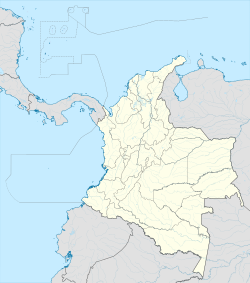
The Viceroyalty of the New Kingdom of Granada, also called Viceroyalty of New Granada or Viceroyalty of Santa Fe, was the name given on 27 May 1717 to the jurisdiction of the Spanish Empire in northern South America, corresponding to modern Colombia, Ecuador, Panama and Venezuela. Created in 1717 by King Felipe V, as part of a new territorial control policy, it was suspended in 1723 for financial problems and was restored in 1739 until the independence movement suspended it again in 1810. The territory corresponding to Panama was incorporated later in 1739, and the provinces of Venezuela were separated from the Viceroyalty and assigned to the Captaincy General of Venezuela in 1777. In addition to those core areas, the territory of the Viceroyalty of New Granada included Guyana, Trinidad and Tobago, southwestern Suriname, parts of northwestern Brazil, and northern Peru. A strip along the Atlantic Ocean in Mosquito Coast was added by the Royal Decree of 20 November 1803, but the British battled for administrative control.

Riohacha is a city in the Riohacha Municipality in the northern Caribbean Region of Colombia by the mouth of the Ranchería River and the Caribbean Sea. It is the capital city of the La Guajira Department. It has a sandy beach waterfront.

The Guajira Peninsula is a peninsula in northern Colombia and northwestern Venezuela in the Caribbean. It is the northernmost peninsula in South America and has an area of 25,000 km2 (9,700 sq mi) extending from the Manaure Bay (Colombia) to the Calabozo Ensenada in the Gulf of Venezuela (Venezuela), and from the Caribbean to the Serranía del Perijá mountains range.

The Wayuu are an Indigenous ethnic group of the Guajira Peninsula in northernmost Colombia and northwest Venezuela. The Wayuu language is part of the Arawakan language family.

La Guajira is a department of Colombia. It occupies most of the Guajira Peninsula in the northeast region of the country, on the Caribbean Sea and bordering Venezuela, at the northernmost tip of South America. The capital city of the department is Riohacha.

Manaure or Salinas de Manaure is a town and municipality located in the Colombian Department of La Guajira. Manaure's main economic activity is the exploitation of the vast amounts of salt in the area.

The Ranchería River is a river located in northern La Guajira Department, Colombia. Born in the Sierra Nevada de Santa Marta southern steps flows south, abruptly turns northeast and then north where it finally flows into the Caribbean Sea. It is the main river of La Guajira Department and has great significance for the Wayuu people.

Barrancas is a town and municipality of the Colombian Department of La Guajira. The municipality of Barrancas is located to the left margin of the Ranchería River in a valley formed between the Sierra Nevada de Santa Marta mountains and the Serranía del Perijá. Barrancas has a total area of 742 km2 and at 40 meters over sea level. The average temperature is 28 °C throughout the year and distances from the capital of the Department of La Guajira, Riohacha. It became a municipality in 1892.

Fonseca is a municipality located in the Colombian Department of La Guajira. The town celebrates the Festival del Retorno in honor of St Augustine with religious celebrations, vallenato music events and others.

Uribia is a town and municipality of the La Guajira department of Colombia. It is the youngest municipality of this Department since the year 2000. Northern Zone of the Cerrejón coal mines are located in this municipality. The municipality also contains the Serranía de Macuira mountain range which is an isolated low altitude mountain range in the middle of La Guajira Desert. One third of this mountain range is also a National Natural Park of Colombia.

Albania is a town and municipality of the Colombian Department of La Guajira. Is the youngest municipality of this Department along with the town of Uribia and others, created on March 19, 2000. Albania neighbours and exclusive enclosed camp site for the Cerrejón coal mine workers and their families, named Mushaisa.

Dibulla is a town and municipality located in the Department of La Guajira, Colombia by the Caribbean Sea and the Sierra Nevada de Santa Marta mountains on the Guajira Peninsula. It was proclaimed municipality in 1995.

The 1st Division is a Colombian National Army division consisting on two brigades; The 2nd Brigade based in the city of Barranquilla and the 10th Armored Brigade based in the city of Valledupar. Its current commander is general Juan Bautista Yepez Bedoya, an infantry officer.

The University of La Guajira, also known as Uniguajira, is a public, departmental university based primarily in the city of Riohacha, La Guajira, Colombia. The university was established by ordinance No. 011 and 012 of 1976, by the Departmental Assembly, and opened in February 1977. Its main campus, known as the University Citadel, is located in the outskirts of the city, and it hosts the faculties of Basic Sciences, Economic and Administrative Sciences, Education Sciences, Engineering, and Social and Humanity Sciences. The university also has several satellite campuses across the department in the cities of Albania, Fonseca, Maicao, Manaure, and Villanueva, and one campus in the department of Córdoba in the city of Montería. The university offers education at technical, undergraduate and postgraduate levels. The mascot is a jellyfish, symbolizing power and simplicity.
The Bahía Portete massacre was a massacre in the Colombian town of Bahía Portete, in the Department of La Guajira on April 16, 2004. It was perpetrated by paramilitary groups of the United Self-Defense Forces of Colombia (AUC) Wayuu Counter-Insurgency Bloc led by alias "Jorge 40" killing 12 people and the disappearance of one. Some 600 people were displaced against their will and took refuge in neighboring Venezuela.

Bahía Portete – Kaurrele National Natural Park is a national natural park in Uribia, La Guajira, Colombia. The northernmost national park of mainland South America is located at the Caribbean coast of the La Guajira peninsula in Bahía Portete, between Cabo de la Vela and Punta Gallinas. Established on December 20, 2014, it is the most recently designated national park of the country. As of 2017, 59 nationally defined protected areas are incorporated in Colombia. The park hosts a high number of marine and terrestrial species.

Riohacha Municipality is located on the Caribbean region of Colombia of La Guajira Department, Colombia. It extends over 3,120 km2 and has an urban part divided into 10 Communes, 14 Corregimientos and 8 Resguardos Indígenas. 7 of the indigenous regions belong to the Wayuu and one in the Sierra Nevada de Santa Marta region shared by the Kogi, the Wiwa, and the Ijka, a subtribe of the Arhuaco people.

Lebanese Colombians are Colombians of Lebanese descent. Most of the Lebanese community's forebears immigrated to Colombia from the Ottoman Empire in the late 19th and early 20th centuries for economic, political and religious reasons. The first Lebanese moved to Colombia in the late nineteenth century. There was another wave in the early twentieth century. It is estimated that over 10,000 Lebanese immigrated to Colombia from 1900 to 1930.

The Battle of Carazúa was a battle of the Thousand Days' War. It took place on 13 September 1901 between Colombia and Venezuela.
La Guajira Cartel refers to a criminal organization originating from Maicao that operates in the Guajira Peninsula on the Caribbean Sea, north of the border between Colombia and Venezuela. Its base territory is the city of Maracaibo and a large part of the state of Zulia in Venezuela, also covers La Guajira Department in Colombia; especially Maicao, and to the north of the Cesar Department, particularly, its capital Valledupar, thus matching the historical territory of the Wayuu indigenous ethnic group, to which some of its members belong. The cartel specializes in the control of contraband of all kinds of supplies; especially, Venezuelan gasoline to Colombia, weapons, minerals, stolen cars, cattle and drug trafficking. They also commit all kinds of robberies, extortion, assassination, threats, kidnappings, and usury.






















